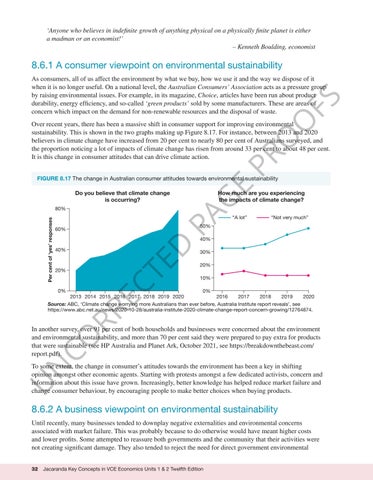“c08EconomicsAndTheEnvironment_PrintPDF” — 2022/6/6 — 17:03 — page 32 — #32
‘Anyone who believes in indefinite growth of anything physical on a physically finite planet is either a madman or an economist!’ – Kenneth Boulding, economist
8.6.1 A consumer viewpoint on environmental sustainability
O
FS
As consumers, all of us affect the environment by what we buy, how we use it and the way we dispose of it when it is no longer useful. On a national level, the Australian Consumers’ Association acts as a pressure group by raising environmental issues. For example, in its magazine, Choice, articles have been run about product durability, energy efficiency, and so-called ‘green products’ sold by some manufacturers. These are areas of concern which impact on the demand for non-renewable resources and the disposal of waste.
PR
O
Over recent years, there has been a massive shift in consumer support for improving environmental sustainability. This is shown in the two graphs making up Figure 8.17. For instance, between 2013 and 2020 believers in climate change have increased from 20 per cent to nearly 80 per cent of Australians surveyed, and the proportion noticing a lot of impacts of climate change has risen from around 33 per cent to about 48 per cent. It is this change in consumer attitudes that can drive climate action.
PA
“A lot”
“Not very much”
50%
60%
20%
TE
40%
D
40%
CO RR EC
Per cent of ‘yes’ responses
80%
How much are you experiencing the impacts of climate change?
G
Do you believe that climate change is occurring?
E
FIGURE 8.17 The change in Australian consumer attitudes towards environmental sustainability
0%
30% 20% 10% 0%
2013 2014 2015 2016 2017 2018 2019 2020
2016
2017
2018
2019
2020
Source: ABC, ‘Climate change worrying more Australians than ever before, Australia Institute report reveals’, see https://www.abc.net.au/news/2020-10-28/australia-institute-2020-climate-change-report-concern-growing/12764874.
In another survey, over 91 per cent of both households and businesses were concerned about the environment and environmental sustainability, and more than 70 per cent said they were prepared to pay extra for products that were sustainable (see HP Australia and Planet Ark, October 2021, see https://breakdownthebeast.com/ report.pdf).
U
N
To some extent, the change in consumer’s attitudes towards the environment has been a key in shifting opinion amongst other economic agents. Starting with protests amongst a few dedicated activists, concern and information about this issue have grown. Increasingly, better knowledge has helped reduce market failure and change consumer behaviour, by encouraging people to make better choices when buying products.
8.6.2 A business viewpoint on environmental sustainability Until recently, many businesses tended to downplay negative externalities and environmental concerns associated with market failure. This was probably because to do otherwise would have meant higher costs and lower profits. Some attempted to reassure both governments and the community that their activities were not creating significant damage. They also tended to reject the need for direct government environmental 32
Jacaranda Key Concepts in VCE Economics Units 1 & 2 Twelfth Edition





















































